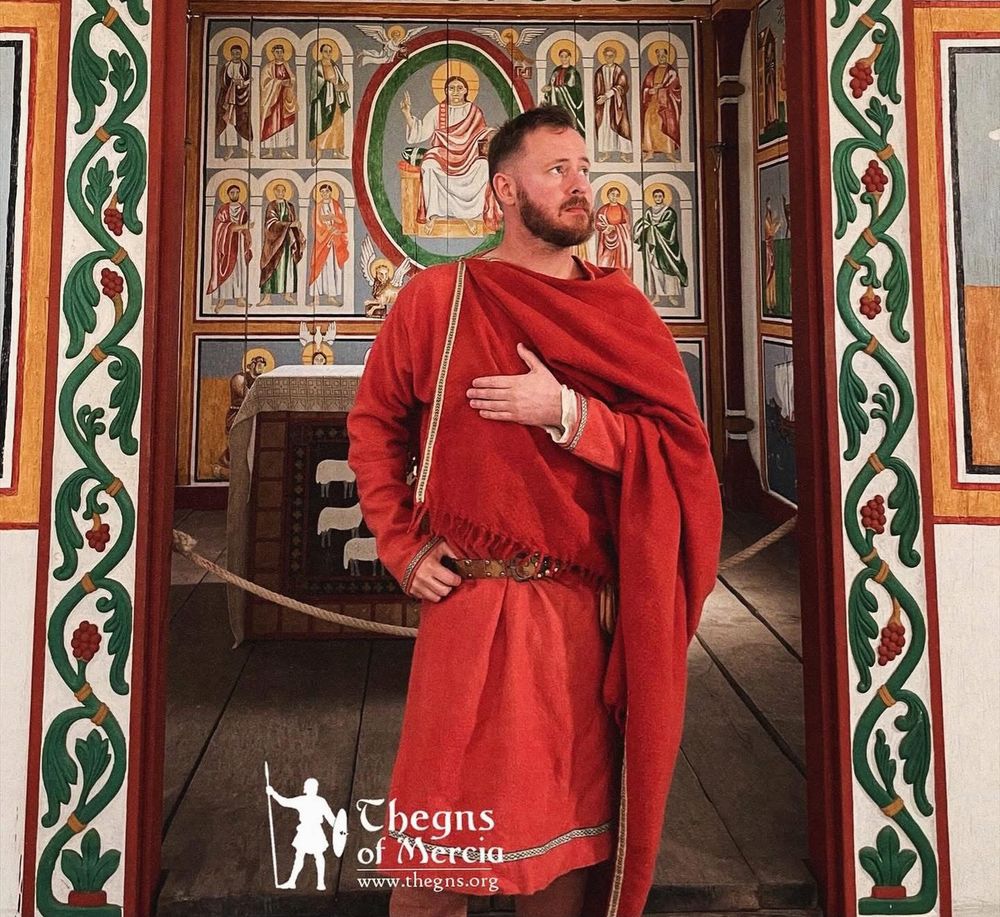
A not-for-profit educational living-history group dedicated to promoting interest in, and celebrating the diverse cultures of late-antiquity / early medieval lowland Britain / the broadest-sense ‘Anglo-Saxon’ period
This neck ring was found in the burial of a child in the piecemeal-excavated early #AngloSaxon cemetery at Ruskington Lincolnshire. (Displayed at Lincoln Museum).
Rare #archaeology finds, such collars…

This neck ring was found in the burial of a child in the piecemeal-excavated early #AngloSaxon cemetery at Ruskington Lincolnshire. (Displayed at Lincoln Museum).
Rare #archaeology finds, such collars…
Replica of the Faversham buckle (found in c19th & displayed in the British Museum @britishmuseum.bsky.social) by Danegeld Historic Jewellery. Belt by member @aedthompson.bsky.social woven from plant dyed wools, on leather.

Replica of the Faversham buckle (found in c19th & displayed in the British Museum @britishmuseum.bsky.social) by Danegeld Historic Jewellery. Belt by member @aedthompson.bsky.social woven from plant dyed wools, on leather.
Previously we shared the foundations of James’ work to reconstruct a plausible image of the Gregorian missionaries and first bishops of the Anglo-Saxon church whose deeds are well documented but… 🧵

Previously we shared the foundations of James’ work to reconstruct a plausible image of the Gregorian missionaries and first bishops of the Anglo-Saxon church whose deeds are well documented but… 🧵


#earlymedieval #medieval #anglosaxon (cooler than #viking #vikings) #migrationperiod #livinghistory #archaeology #reenactment

#earlymedieval #medieval #anglosaxon (cooler than #viking #vikings) #migrationperiod #livinghistory #archaeology #reenactment



Find out more at www.thegns.org/blog/yule
(Article by Æd Thompson, for Sutton Hoo’s #Yule exhibition)

Find out more at www.thegns.org/blog/yule
(Article by Æd Thompson, for Sutton Hoo’s #Yule exhibition)

One of 12 such lyres (so far) found in early Anglo-Saxon graves, this example uniquely features horn veneers & silver pins on the yoke, placing its tuning pegs within a representation of the night sky.
#archaeology #livinghistory #medieval

One of 12 such lyres (so far) found in early Anglo-Saxon graves, this example uniquely features horn veneers & silver pins on the yoke, placing its tuning pegs within a representation of the night sky.
#archaeology #livinghistory #medieval
museum in Govan Old.
Note the shallow carving, making it more like Pictish carvings than the heavier relief produced in the Brittonic Viking-Age Kingdom of Strathclyde.

museum in Govan Old.
Note the shallow carving, making it more like Pictish carvings than the heavier relief produced in the Brittonic Viking-Age Kingdom of Strathclyde.
… And now with this much bigger character limit we can outline how, in reality, evidence including archaeoDNA meta-analysis shows we were a diverse mixture of…
… And now with this much bigger character limit we can outline how, in reality, evidence including archaeoDNA meta-analysis shows we were a diverse mixture of…
Reminds us of the Migration Period.
#medieval #archaeology
Reminds us of the Migration Period.
#medieval #archaeology
The exciting kicker is that the runes are ANGLIAN, not Old Norse, likely made by an Anglo-Saxon Northumbrian.
My images from the Treasure Trove in Scotland viewing.




The exciting kicker is that the runes are ANGLIAN, not Old Norse, likely made by an Anglo-Saxon Northumbrian.
My images from the Treasure Trove in Scotland viewing.
Be like your predecessors — dare to be different.

Be like your predecessors — dare to be different.
… And now with this much bigger character limit we can outline how, in reality, evidence including archaeoDNA meta-analysis shows we were a diverse mixture of…
… And now with this much bigger character limit we can outline how, in reality, evidence including archaeoDNA meta-analysis shows we were a diverse mixture of…
Reminds us of the Migration Period.
#medieval #archaeology
Reminds us of the Migration Period.
#medieval #archaeology


